Determinants of Decoupling Economic Output from Carbon Emission in the Transport Sector: A Comparison Study of Four Municipalities in China
Abstract
1. Introduction
2. Literature review
2.1. Literature Review on Decoupling Analysis
2.2. Literature Review on Decomposition Analysis
3. Materials and Methods
3.1. Calculation of Carbon Emission in Transport Sector
3.2. Carbon Decoupling Model
3.3. Using the LMDI Method on the Driving Factors of Transport Carbon Emission
3.4. Data Sources
4. Empirical Results and Analysis
4.1. Study Overview
4.1.1. Beijing City
4.1.2. Shanghai City
4.1.3. Tianjin City
4.1.4. Chongqing City
4.2. Analysis on the Decoupling State of the Transport Sector
4.2.1. Beijing City
4.2.2. Shanghai City
4.2.3. Tianjin city
4.2.4. Chongqing City
4.3. Analysis of the Driving Factors of Carbon Emission Decoupling in the Transport Sector
4.3.1. Beijing City
4.3.2. Shanghai City
4.3.3. Tianjin City
4.3.4. Chongqing City
5. Discussion
6. Conclusions and Policy Recommendations
Author Contributions
Funding
Conflicts of Interest
References
- Fan, Y.V.; Perry, S.; Klemeš, J.J.; Lee, C.T. A review on air emissions assessment: Transportation. J. Clean. Prod. 2018, 194, 673–684. [Google Scholar] [CrossRef]
- Li, Y.; Du, Q.; Lu, X.; Wu, J.; Han, X. Relationship between the development and CO2 emissions of transport sector in China. Transp. Res. Part D Transp. Environ. 2019, 74, 1–14. [Google Scholar] [CrossRef]
- Du, H.; Chen, Z.; Peng, B.; Southworth, F.; Ma, S.; Wang, Y. What drives CO2 emissions from the transport sector? A linkage analysis. Energy 2019, 175, 195–204. [Google Scholar] [CrossRef]
- National Bureau of Statistics of China. China’s Auto Market Almanac; China Commercial Publishing House: Beijing, China, 2017. [Google Scholar]
- Yang, L.; Yang, Y.; Zhang, X.; Tang, K. Whether China’s industrial sectors make efforts to reduce CO2 emissions from production?—A decomposed decoupling analysis. Energy 2018, 160, 796–809. [Google Scholar] [CrossRef]
- Wu, Y.; Tam, V.W.Y.; Shuai, C.; Shen, L.; Zhang, Y.; Liao, S. Decoupling China’s economic growth from carbon emissions: Empirical studies from 30 Chinese provinces (2001–2015). Sci. Total Environ. 2019, 656, 576–588. [Google Scholar] [CrossRef]
- Wu, Y.; Shen, L.; Zhang, Y.; Shuai, C.; Yan, H.; Lou, Y.; Ye, G. A new panel for analyzing the impact factors on carbon emission: A regional perspective in China. Ecol. Indic. 2019, 97, 260–268. [Google Scholar] [CrossRef]
- Huang, F.; Zhou, D.; Wang, Q.; Hang, Y. Decomposition and attribution analysis of the transport sector’s carbon dioxide intensity change in China. Transp. Res. Part A Policy Pr. 2019, 119, 343–358. [Google Scholar] [CrossRef]
- Wang, Q.; Su, M.; Li, R.; Ponce, P. The effects of energy prices, urbanization and economic growth on energy consumption per capita in 186 countries. J. Clean. Prod. 2019, 225, 1017–1032. [Google Scholar] [CrossRef]
- Chen, J.; Shen, L.; Song, X.; Shi, Q.; Li, S. An empirical study on the CO2 emissions in the Chinese construction industry. J. Clean. Prod. 2017, 168, 645–654. [Google Scholar] [CrossRef]
- Zhang, Z. Decoupling China’s carbon emissions increase from economic growth: An economic analysis and policy implications. World Dev. 2000, 28, 739–752. [Google Scholar] [CrossRef]
- Riti, J.S.; Song, D.; Shu, Y.; Kamah, M. Decoupling CO2 emission and economic growth in China: Is there consistency in estimation results in analyzing environmental Kuznets curve? J. Clean. Prod. 2017, 166, 1448–1461. [Google Scholar] [CrossRef]
- Wang, Q.; Su, M.; Li, R. Toward to economic growth without emission growth: The role of urbanization and industrialization in China and India. J. Clean. Prod. 2018, 205, 499–511. [Google Scholar] [CrossRef]
- Zhou, X.; Zhang, M.; Zhou, M.; Zhou, M. A comparative study on decoupling relationship and influence factors between China’s regional economic development and industrial energy–related carbon emissions. J. Clean. Prod. 2017, 142, 783–800. [Google Scholar] [CrossRef]
- Wang, Q.; Zhao, M.; Li, R.; Su, M. Decomposition and decoupling analysis of carbon emissions from economic growth: A comparative study of China and the United States. J. Clean. Prod. 2018, 197, 178–184. [Google Scholar] [CrossRef]
- Zhao, L.; Liang, R.; Zhang, J.; Wu, W. Internet time-delay prediction based on Wavelet transformation and ARIMA. Appl. Energy 2015, 158, 142–156. [Google Scholar] [CrossRef]
- Wang, W.; Liu, R.; Zhang, M.; Li, H. Decomposing the decoupling of energy-related CO2 emissions and economic growth in Jiangsu Province. Energy Sustain. Dev. 2013, 17, 62–71. [Google Scholar] [CrossRef]
- Lu, Q.; Yang, H.; Huang, X.; Chuai, X.; Wu, C. Multi-sectoral decomposition in decoupling industrial growth from carbon emissions in the developed Jiangsu Province, China. Energy 2015, 82, 414–425. [Google Scholar] [CrossRef]
- Zhao, M.-M.; Li, R. Decoupling and decomposition analysis of carbon emissions from economic output in Chinese Guangdong Province: A sector perspective. Energy Environ. 2018, 29, 543–555. [Google Scholar] [CrossRef]
- Zhen, W.; Qin, Q.; Kuang, Y.; Huang, N. Investigating low-carbon crop production in Guangdong Province, China (1993–2013): A decoupling and decomposition analysis. J. Clean. Prod. 2017, 146, 63–70. [Google Scholar] [CrossRef]
- Wang, Q.; Jiang, R. Is China’s economic growth decoupled from carbon emissions? J. Clean. Prod. 2019, 225, 1194–1208. [Google Scholar] [CrossRef]
- Wang, Z.; Yang, L. Delinking indicators on regional industry development and carbon emissions: Beijing–Tianjin–Hebei economic band case. Ecol. Indic. 2015, 48, 41–48. [Google Scholar] [CrossRef]
- Zhang, X.; Zhao, Y.; Wang, C.; Wang, F.; Qiu, F. Decoupling effect and sectoral attribution analysis of industrial energy-related carbon emissions in Xinjiang, China. Ecol. Indic. 2019, 97, 1–9. [Google Scholar] [CrossRef]
- Yu, Y.; Zhou, L.; Zhou, W.; Ren, H.; Kharrazi, A.; Ma, T.; Zhu, B. Decoupling environmental pressure from economic growth on city level: The Case Study of Chongqing in China. Ecol. Indic. 2017, 75, 27–35. [Google Scholar] [CrossRef]
- Wang, Q.; Zhao, M.; Li, R. Decoupling sectoral economic output from carbon emissions on city level: A comparative study of Beijing and Shanghai, China. J. Clean. Prod. 2019, 209, 126–133. [Google Scholar] [CrossRef]
- Li, L.; Shan, Y.; Lei, Y.; Wu, S.; Yu, X.; Lin, X.; Chen, Y. Decoupling of economic growth and emissions in China’s cities: A case study of the Central Plains urban agglomeration. Appl. Energy 2019, 244, 36–45. [Google Scholar] [CrossRef]
- Ren, S.; Yin, H.; Chen, X. Using LMDI to analyze the decoupling of carbon dioxide emissions by China’s manufacturing industry. Environ. Dev. 2014, 9, 61–75. [Google Scholar] [CrossRef]
- Wan, L.; Wang, Z.-L.; Ng, C.J. Measurement Research on the Decoupling Effect of Industries’ Carbon Emissions—Based on the Equipment Manufacturing Industry in China. Energies 2016, 9. [Google Scholar] [CrossRef]
- Tang, Z.; Shang, J.; Shi, C.; Liu, Z.; Bi, K. Decoupling indicators of CO2 emissions from the tourism industry in China: 1990–2012. Ecol. Indic. 2014, 46, 390–397. [Google Scholar] [CrossRef]
- Zhu, X.; Li, R. An Analysis of Decoupling and Influencing Factors of Carbon Emissions from the Transportation Sector in the Beijing–Tianjin–Hebei Area, China. Sustainability 2017, 9, 722. [Google Scholar] [CrossRef]
- Wu, Y.; Chau, K.W.; Lu, W.; Shen, L.; Shuai, C.; Chen, J. Decoupling relationship between economic output and carbon emission in the Chinese construction industry. Environ. Impact Assess.Rev. 2018, 71, 60–69. [Google Scholar] [CrossRef]
- Lu, Y.; Cui, P.; Li, D. Carbon emissions and policies in China’s building and construction industry: Evidence from 1994 to 2012. Build. Environ. 2016, 95, 94–103. [Google Scholar] [CrossRef]
- Boqiang, L.; Liu, K. Using LMDI to Analyze the Decoupling of Carbon Dioxide Emissions from China’s Heavy Industry. Sustainability 2017, 9, 1198. [Google Scholar] [CrossRef]
- Jiang, R.; Zhou, Y.; Li, R. Moving to a Low-Carbon Economy in China: Decoupling and Decomposition Analysis of Emission and Economy from a Sector Perspective. Sustainability 2018, 10, 978. [Google Scholar] [CrossRef]
- Yang, L.; Li, Y. Low-carbon City in China. Sustain. Cities Soc. 2013, 9, 62–66. [Google Scholar] [CrossRef]
- Dhakal, S. Urban energy use and carbon emissions from cities in China and policy implications. Energy Policy 2009, 37, 4208–4219. [Google Scholar] [CrossRef]
- Yan, X.; Crookes, R.J. Reduction potentials of energy demand and GHG emissions in China’s road transport sector. Energy Policy 2009, 37, 658–668. [Google Scholar] [CrossRef]
- CAS Sustainable Development Strategy Study Group. China Sustainable Development Strategy Report 2009—China’s Approach Towards a Low Carbon Future; Science Press: Beijing, China, 2009. [Google Scholar]
- Diakoulaki, D.; Mandaraka, M. Decomposition analysis for assessing the progress in decoupling industrial growth from CO2 emissions in the EU manufacturing sector. Energy Econ. 2007, 29, 636–664. [Google Scholar] [CrossRef]
- Wang, Q.; Jiang, R.; Zhan, L. Is decoupling economic growth from fuel consumption possible in developing countries? – A comparison of China and India. J. Clean. Prod. 2019, 229, 806–817. [Google Scholar] [CrossRef]
- Dennehy, E.R.; Gallachóir, B.P.Ó. Ex-post decomposition analysis of passenger car energy demand and associated CO2 emissions. Transp. Res. Part D Transp. Environ. 2018, 59, 400–416. [Google Scholar] [CrossRef]
- Wang, Z.; Liu, W. The Impacts of Individual Behavior on Household Daily Travel Carbon Emissions in Beijing, China. Energy Procedia 2014, 61, 1318–1322. [Google Scholar] [CrossRef]
- Ma, J.; Heppenstall, A.; Harland, K.; Mitchell, G. Synthesising carbon emission for mega-cities: A static spatial microsimulation of transport CO2 from urban travel in Beijing. Comput. Environ. Urban Syst. 2014, 45, 78–88. [Google Scholar] [CrossRef]
- Fan, F.; Lei, Y. Decomposition analysis of energy-related carbon emissions from the transportation sector in Beijing. Transp. Res. Part D Transp. Environ. 2016, 42, 135–145. [Google Scholar] [CrossRef]
- Wang, Y.; Hayashi, Y.; Kato, H.; Liu, C. Decomposition analysis of CO2 emissions increase from the passenger transport sector in Shanghai, China. Int. J. Urban Sci. 2011, 15, 121–136. [Google Scholar] [CrossRef]
- Kai-Ya, W.U.; Cai-Hong, H.E.; Wang, G.X.; Zhang, H. Measurement and Decomposition Analysis on Carbon Emissions of Transportation Industry in Shanghai. Econ. Geogr. 2012, 11, 11–25. [Google Scholar]
- Lanza, R.; Martinsen, T.; Mohammad, A.K.W.; Santos, M.M.O.; Neelis, M.; Patel, M. 2006 IPCC Guidelines for National Greenhouse Gas Inventories; IPCC: Geneva, Switzerland, 2006. [Google Scholar]
- Tapio, P. Towards a theory of decoupling: Degrees of decoupling in the EU and the case of road traffic in Finland between 1970 and 2001. Transp. Policy 2005, 12, 137–151. [Google Scholar] [CrossRef]
- Su, B.; Ang, B.W. Structural decomposition analysis applied to energy and emissions: Some methodological developments. Energy Econ. 2012, 34, 177–188. [Google Scholar] [CrossRef]
- Ang, B.W.; Zhang, F.Q. A survey of index decomposition analysis in energy and environmental studies. Energy 2000, 25, 1149–1176. [Google Scholar] [CrossRef]
- Wang, Q.; Jiang, X.-T.; Yang, X.; Ge, S. Comparative analysis of drivers of energy consumption in China, the USA and India—A perspective from stratified heterogeneity. Sci. Total Environ. 2019, 698, 134117. [Google Scholar] [CrossRef]
- Ang, B.W. Decomposition analysis for policymaking in energy: Which is the preferred method? Energy Policy 2004, 32, 1131–1139. [Google Scholar] [CrossRef]
- Ang, B.W.; Choi, K.H. Decomposition of Aggregate Energy and Gas Emission Intensities for Industry: A Refined Divisia Index Method. Energy J. 1997, 18, 59–73. [Google Scholar] [CrossRef]
- Kaya, Y. Impact of Carbon Dioxide Emission Control on GNP Growth: Interpretation of Proposed Scenarios IPCC Energy and Industry Subgroup, Response Strategies Working Group; Scientific Research: Paris, France, 1990. [Google Scholar]
- National Bureau of Statistics of China. China Energy Statistical Yearbook 2017; Department of Energy Statistics, National Bureau of Statistics: Beijing, China, 2017. [Google Scholar]
- National Bureau of Statistics of China. China Statistical Yearbook 2016; China Statistics Publishing House: Beijing, China, 2016. [Google Scholar]
- Zhao, X.; Zhang, X.; Li, N.; Shao, S.; Geng, Y. Decoupling economic growth from carbon dioxide emissions in China: A sectoral factor decomposition analysis. J. Clean. Prod. 2017, 142, 3500–3516. [Google Scholar] [CrossRef]
- Liu, N.; Ma, Z.; Kang, J. Changes in carbon intensity in China’s industrial sector: Decomposition and attribution analysis. Energy Policy 2015, 87, 28–38. [Google Scholar] [CrossRef]
- Hasanbeigi, A.; Price, L.; Fino-Chen, C.; Lu, H.; Ke, J. Retrospective and prospective decomposition analysis of Chinese manufacturing energy use and policy implications. Energy Policy 2013, 63, 562–574. [Google Scholar] [CrossRef]
- Pan, X.; Wang, H.; Wang, L.; Chen, W. Decarbonization of China’s transportation sector: In light of national mitigation toward the Paris Agreement goals. Energy 2018, 155, 853–864. [Google Scholar] [CrossRef]
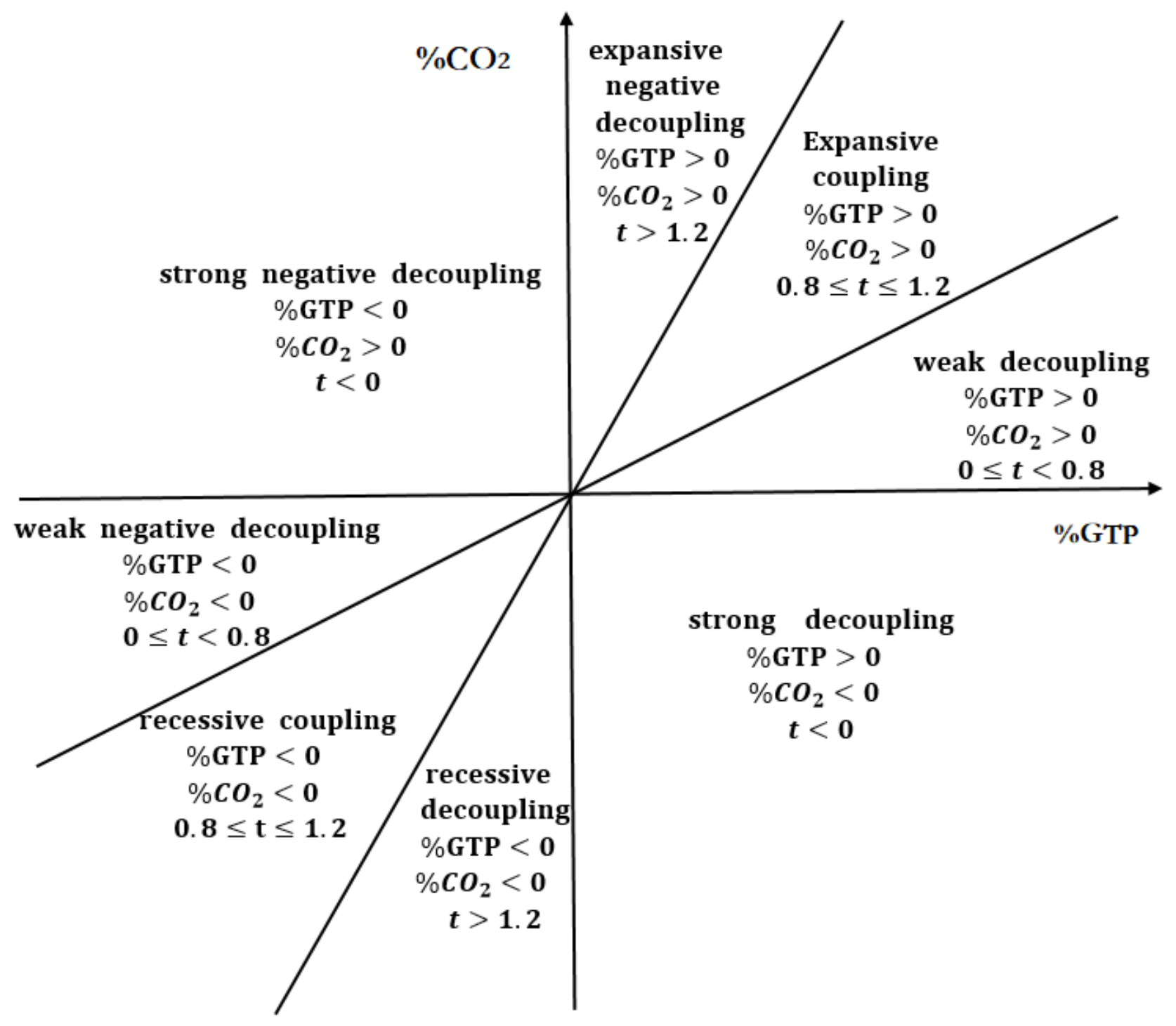
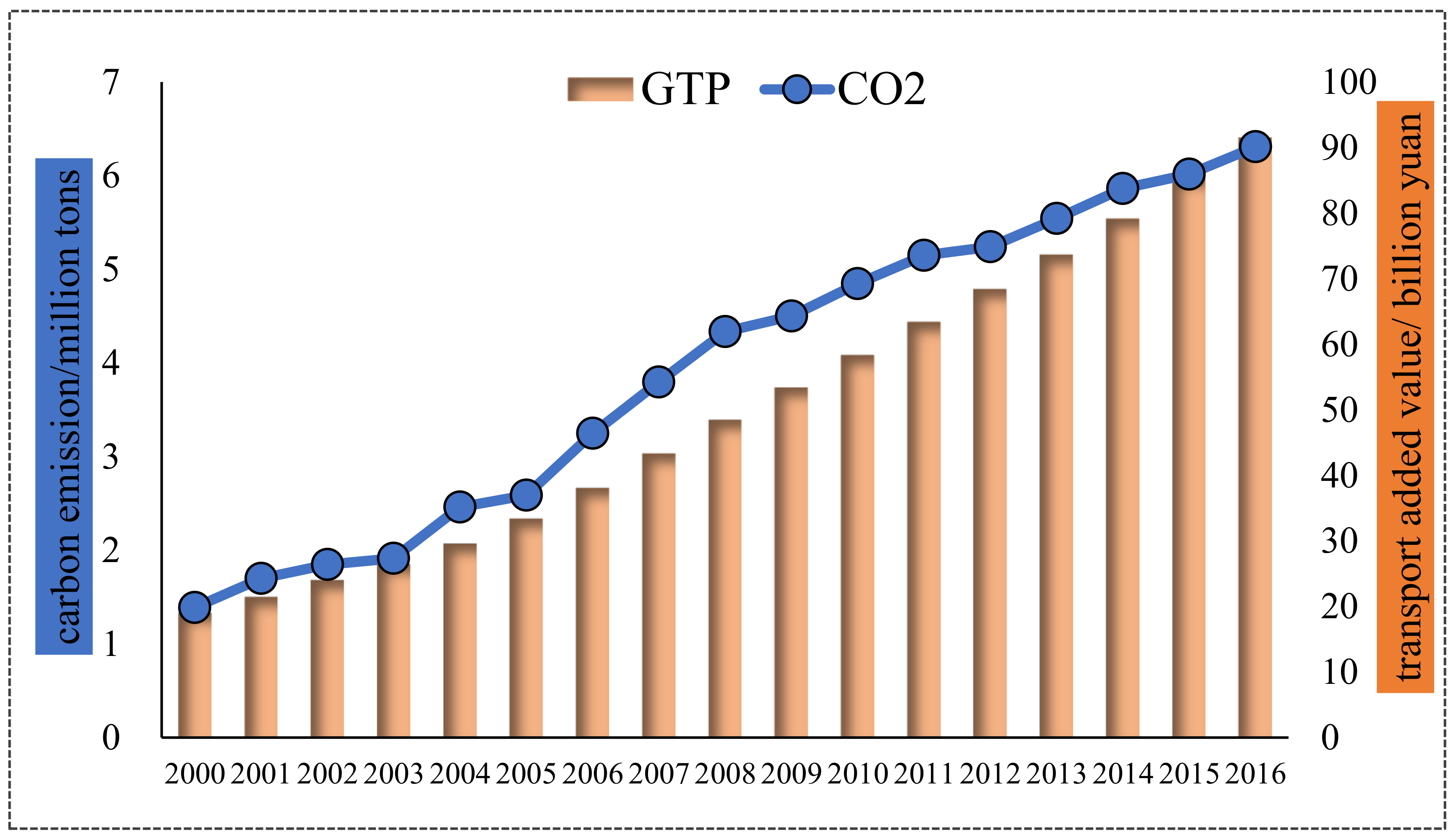
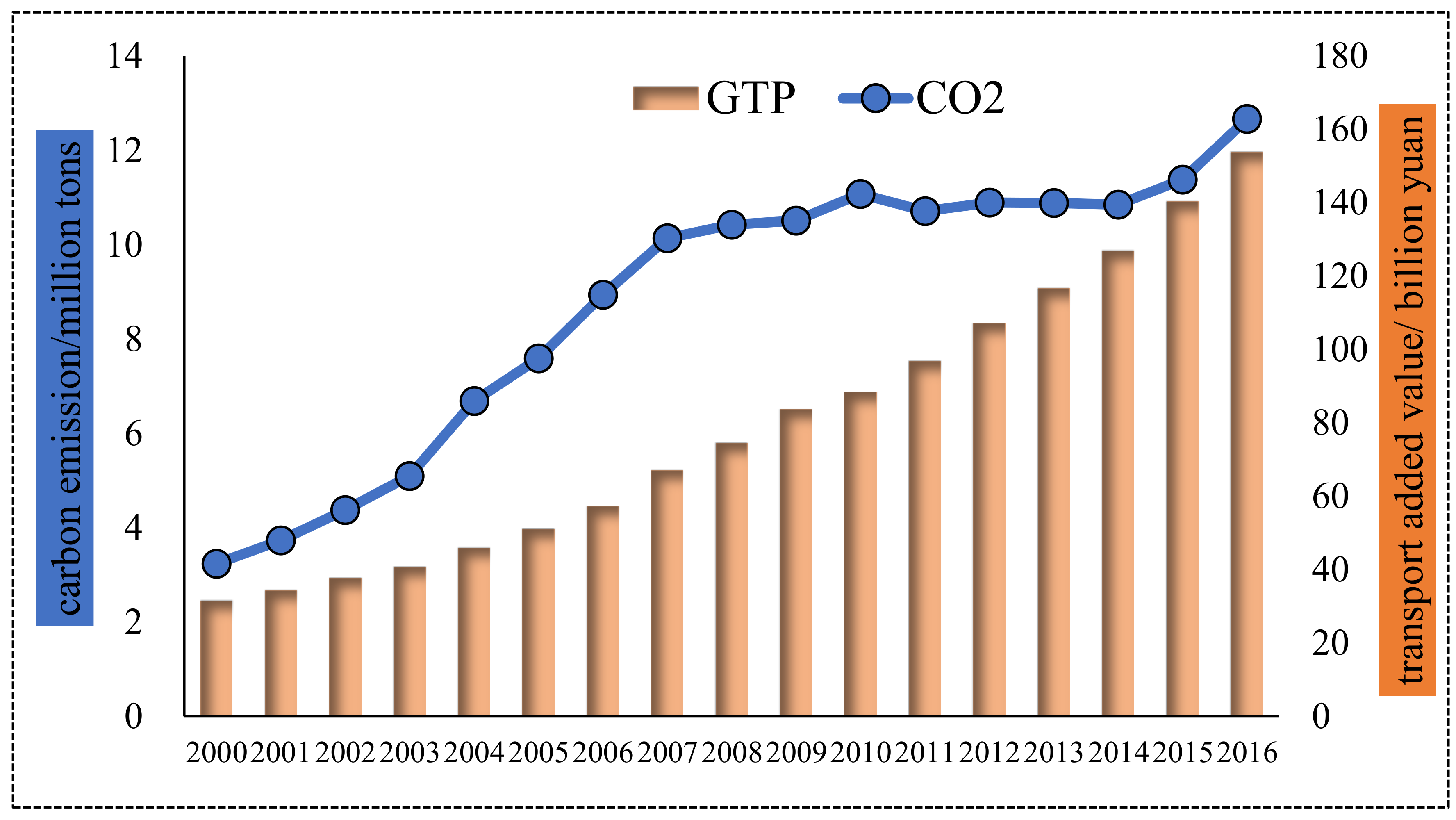
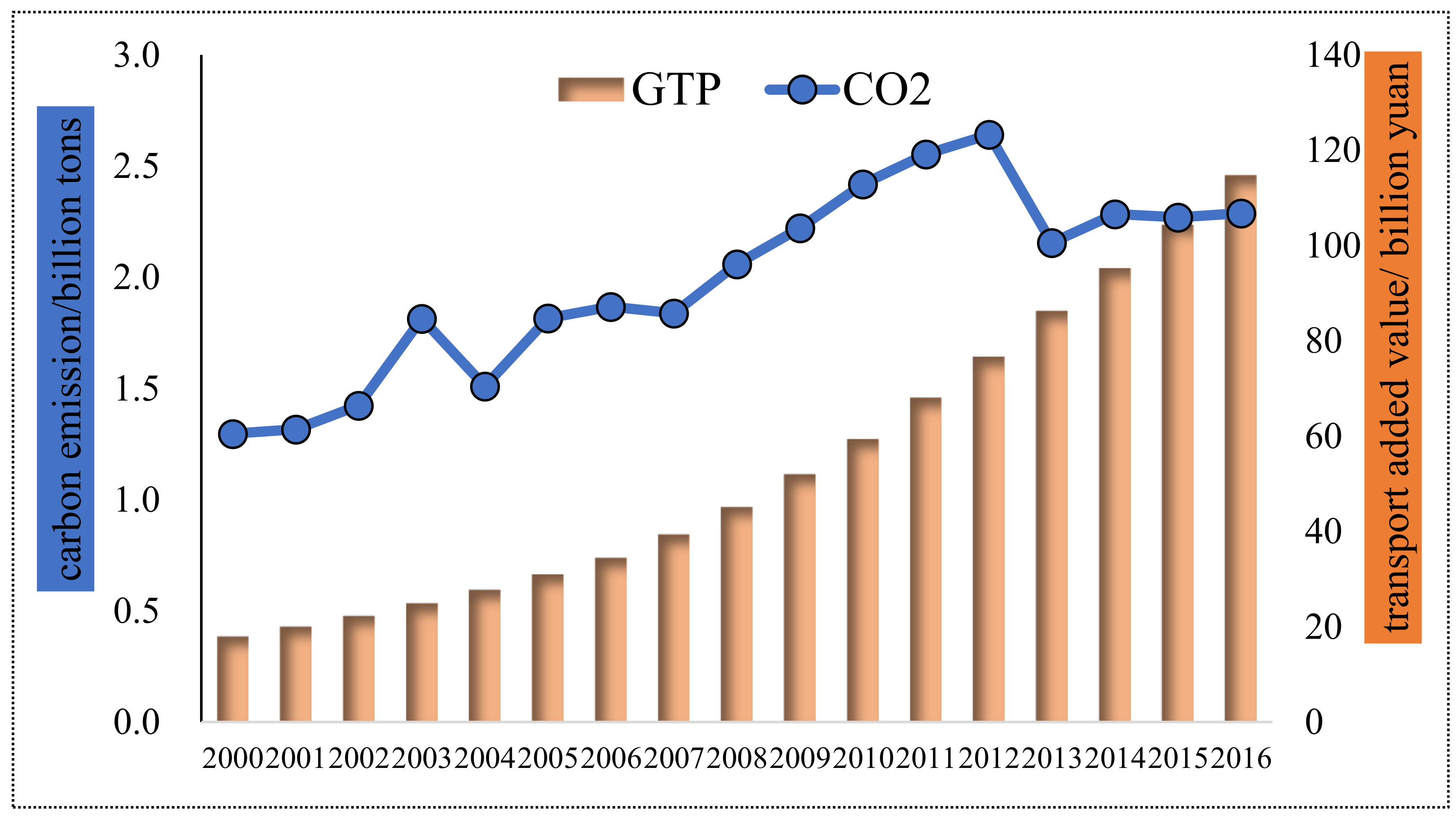
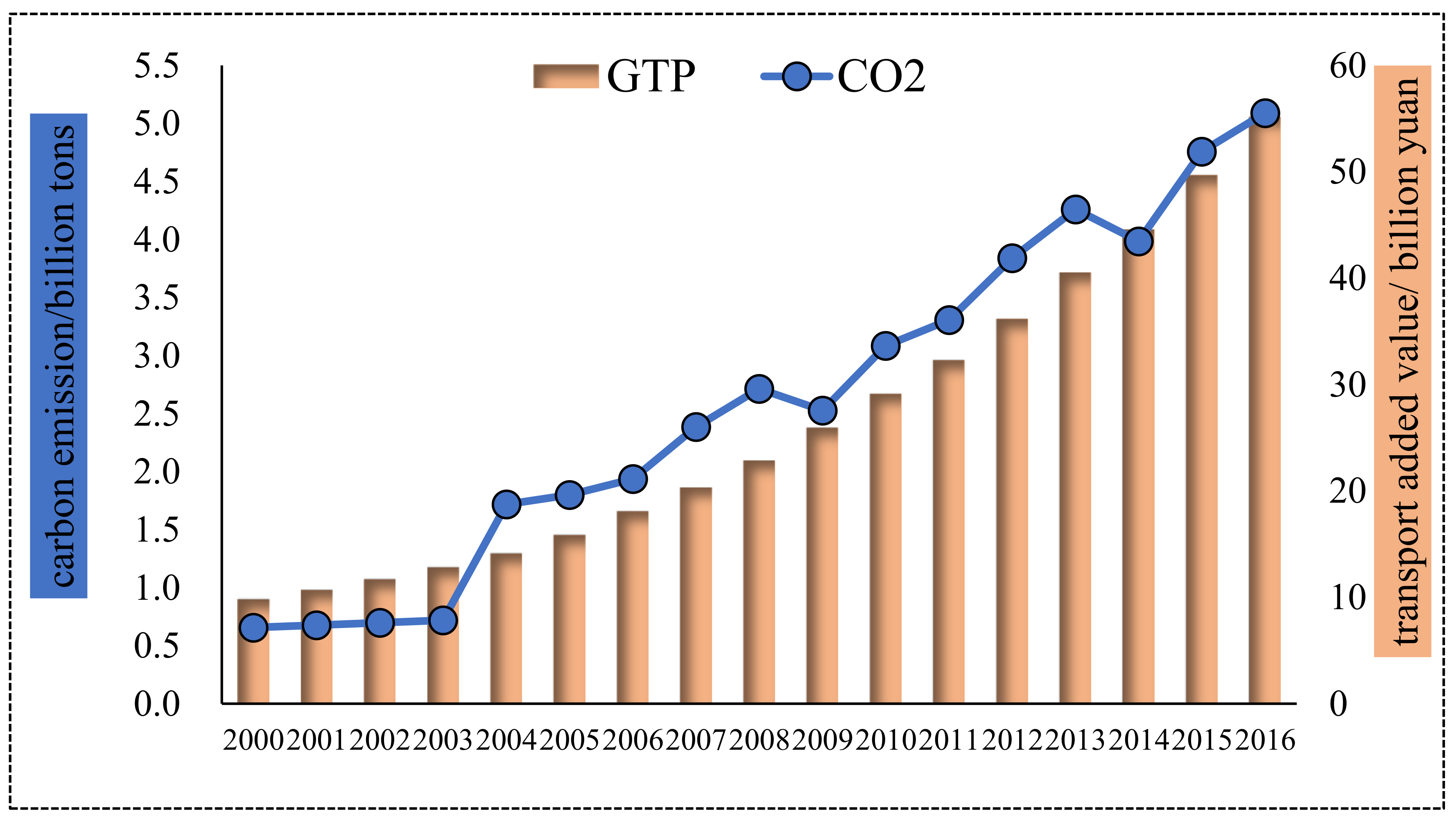
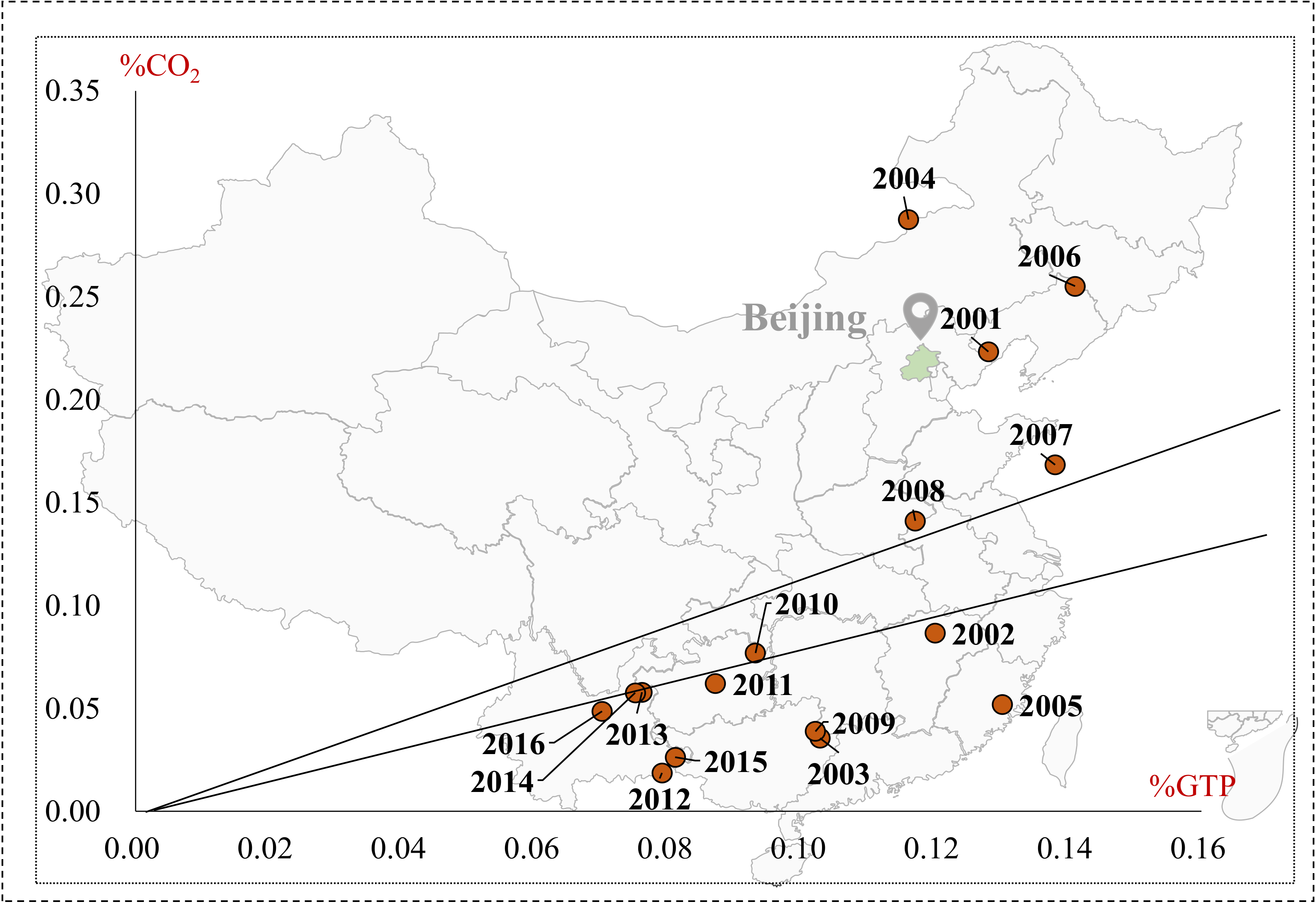
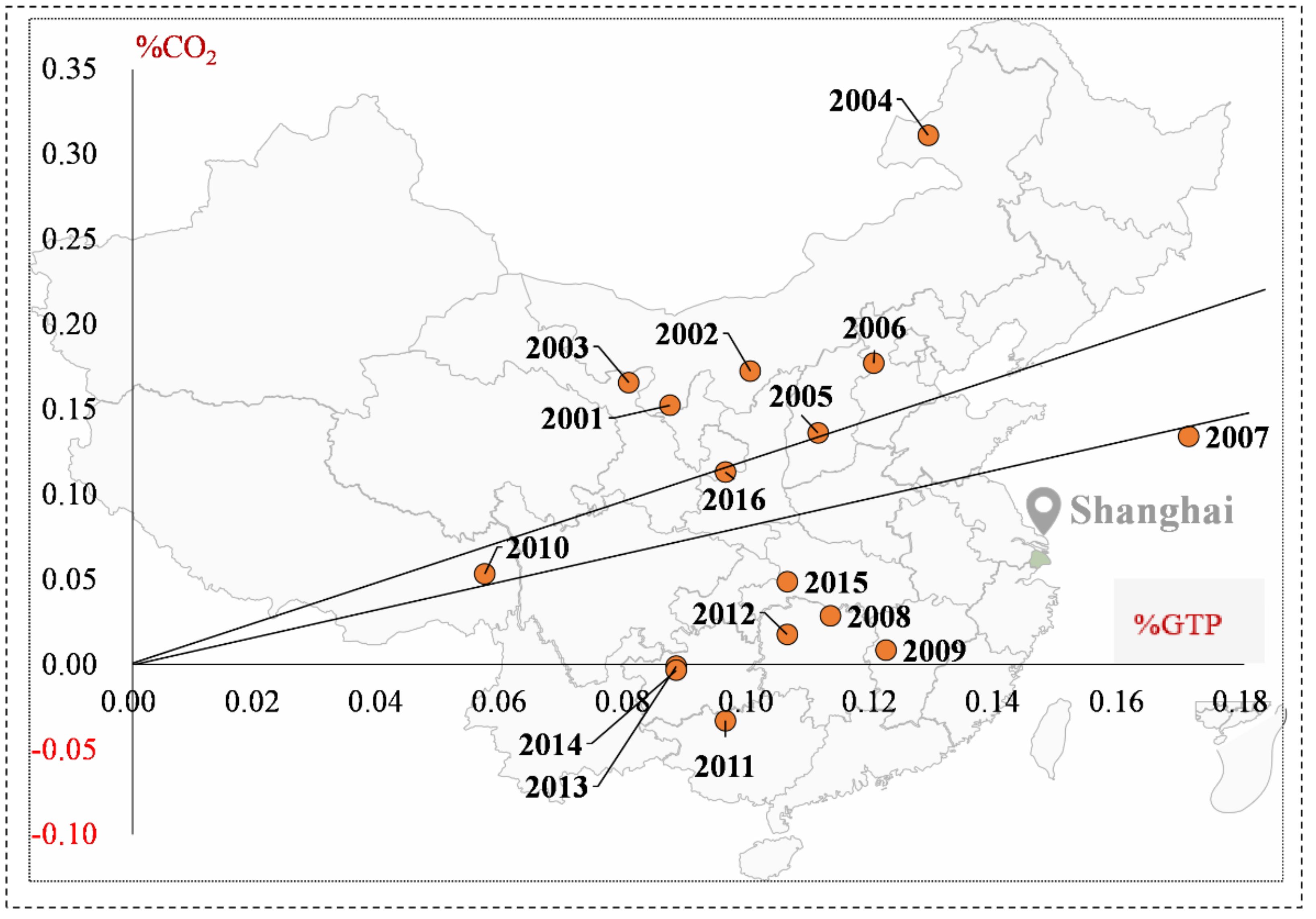
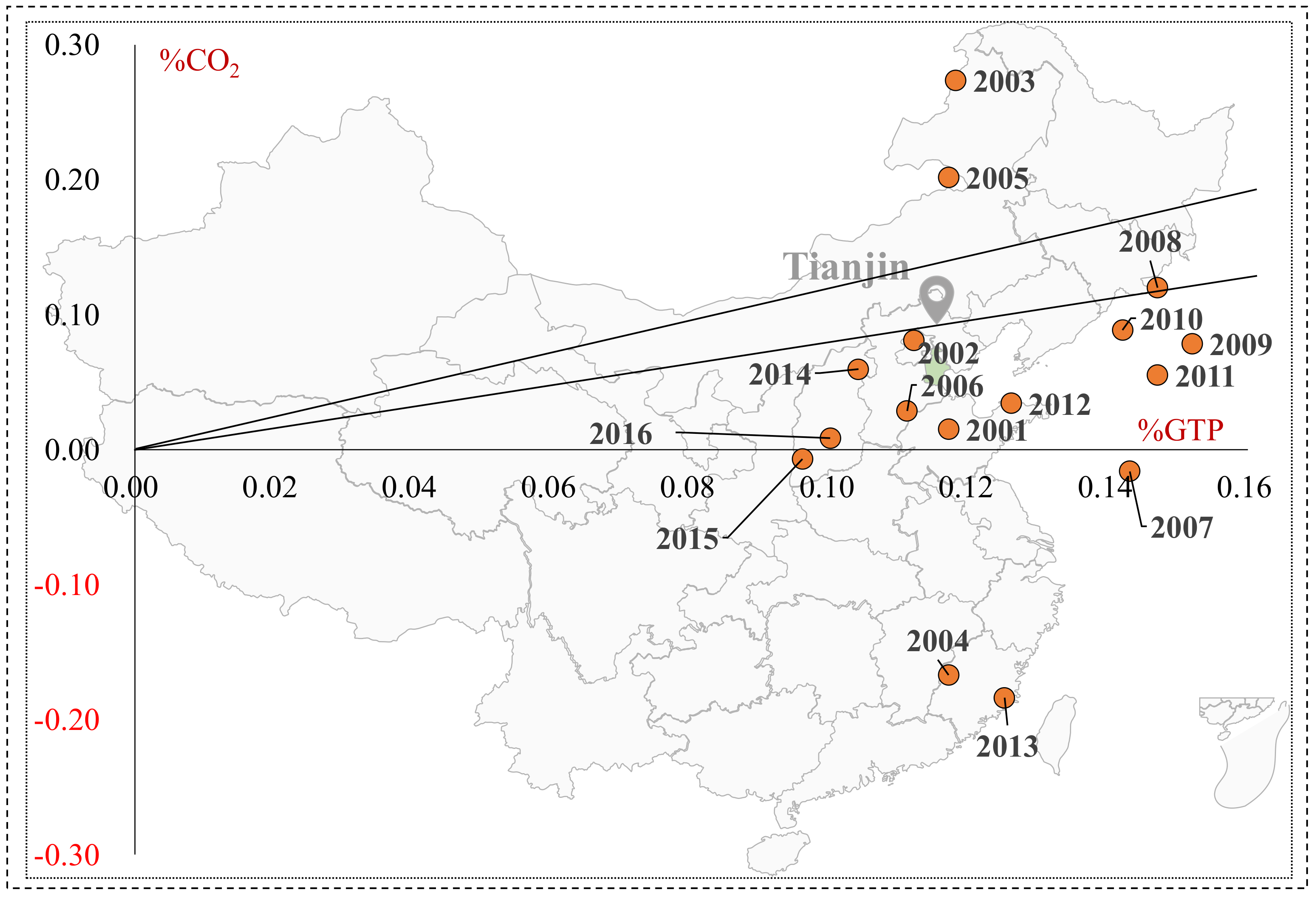
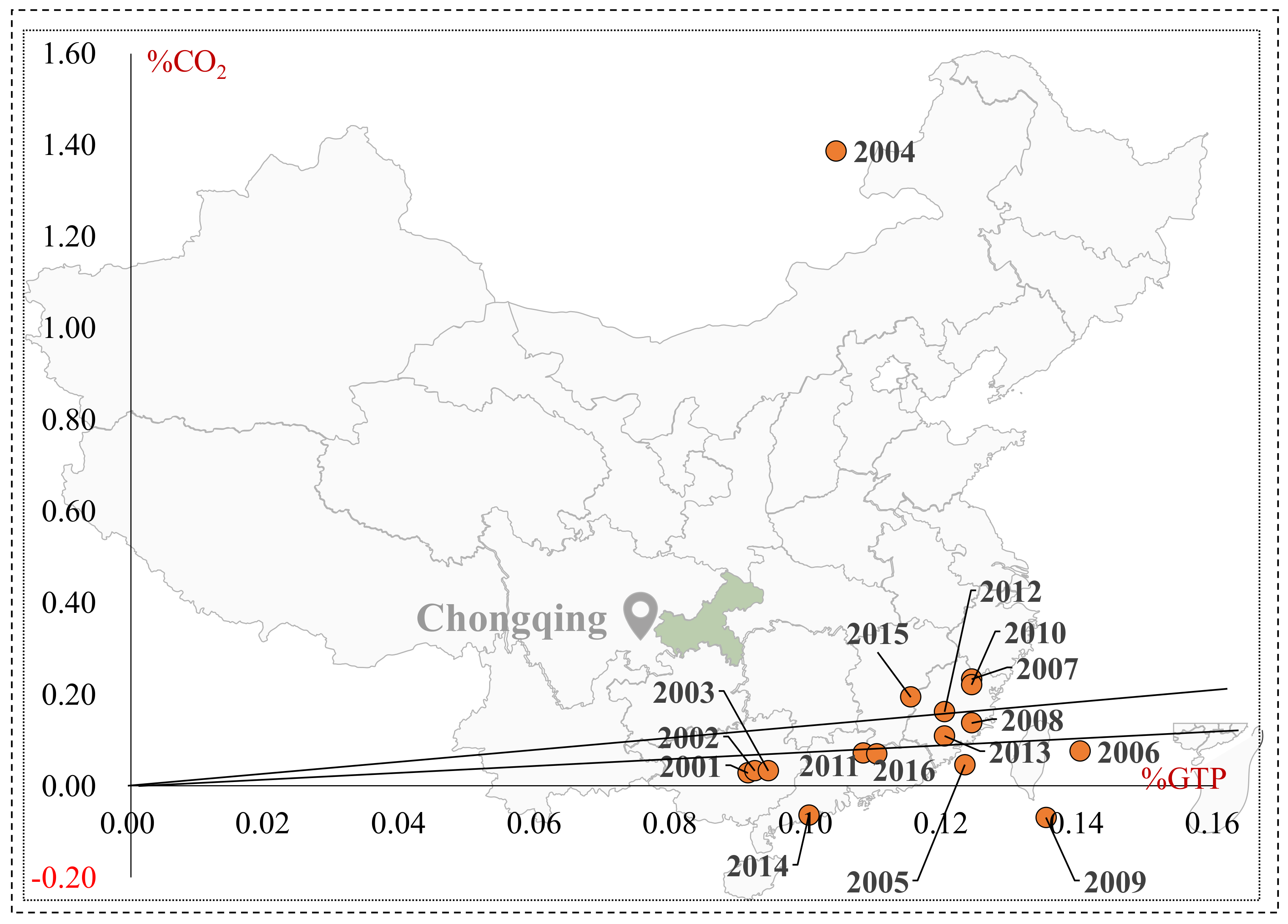
| Energy Type | Energy Conversion Coefficient (10-6TJ/Kg or m3) | Carbon Emission Factor (t/Kg) | Carbon Oxidation Rate |
|---|---|---|---|
| raw coal | 20.908 | 25.8 | 0.90 |
| coke | 28.435 | 29.2 | 0.93 |
| fuel oil | 41.816 | 21.1 | 0.98 |
| gasoline | 42.070 | 18.9 | 0.98 |
| kerosene | 43.070 | 19.6 | 0.98 |
| diesel | 42.652 | 20.2 | 0.98 |
| natural gas | 38.931 | 15.3 | 0.99 |
| Year | Individual Influencing Factors | Total | ||||||||||
|---|---|---|---|---|---|---|---|---|---|---|---|---|
| tr | State | ts | State | td | State | tf | State | tp | State | t | State | |
| 2000–2001 | 0.12 | WD | 0.58 | WD | 0.12 | WD | 0.79 | WD | 0.13 | WD | 1.74 | END |
| 2001–2002 | 0.05 | WD | –0.31 | SD | 0.13 | WD | 0.62 | WD | 0.24 | WD | 0.72 | WD |
| 2002–2003 | –0.08 | SD | –0.55 | SD | –0.04 | SD | 0.78 | WD | 0.23 | WD | 0.35 | WD |
| 2003–2004 | 0.04 | WD | 1.36 | END | –0.14 | SD | 0.97 | EC | 0.25 | WD | 2.48 | END |
| 2004–2005 | 0.02 | WD | –0.58 | SD | 0.08 | WD | 0.65 | WD | 0.23 | WD | 0.40 | WD |
| 2005–2006 | 0.03 | WD | 0.73 | WD | 0.09 | WD | 0.64 | WD | 0.32 | WD | 1.81 | END |
| 2006–2007 | 0.02 | WD | 0.19 | WD | 0.03 | WD | 0.62 | WD | 0.36 | WD | 1.22 | END |
| 2007–2008 | 0.03 | WD | 0.16 | WD | 0.22 | WD | 0.28 | WD | 0.50 | WD | 1.20 | END |
| 2008–2009 | 0.02 | WD | –0.61 | SD | 0.00 | SD | 0.48 | WD | 0.49 | WD | 0.38 | WD |
| 2009–2010 | 0.08 | WD | –0.24 | SD | –0.10 | SD | 0.50 | WD | 0.60 | WD | 0.83 | EC |
| 2010–2011 | 0.03 | WD | –0.31 | SD | 0.07 | WD | 0.58 | WD | 0.34 | WD | 0.71 | WD |
| 2011–2012 | –0.03 | SD | –0.71 | SD | 0.02 | WD | 0.64 | WD | 0.31 | WD | 0.23 | WD |
| 2012–2013 | 0.06 | WD | –0.29 | SD | –0.01 | SD | 0.71 | WD | 0.30 | WD | 0.76 | WD |
| 2013–2014 | –0.02 | SD | –0.20 | SD | 0.03 | WD | 0.73 | WD | 0.24 | WD | 0.77 | WD |
| 2014–2015 | 0.07 | WD | –0.72 | SD | 0.14 | WD | 0.72 | WD | 0.11 | WD | 0.32 | WD |
| 2015–2016 | 0.05 | WD | –0.34 | SD | 0.03 | WD | 0.95 | EC | 0.01 | WD | 0.69 | WD |
| Year | Individual Influencing Factors | Total | ||||||||||
|---|---|---|---|---|---|---|---|---|---|---|---|---|
| tr | State | ts | State | td | State | tf | State | tp | State | t | State | |
| 2000–2001 | –0.06 | SD | 0.78 | WD | –0.17 | SD | 0.75 | WD | 0.44 | WD | 1.75 | END |
| 2001–2002 | 0.01 | WD | 0.68 | WD | –0.09 | SD | 0.83 | EC | 0.29 | WD | 1.72 | END |
| 2002––2003 | 0.02 | WD | 1.00 | EC | –0.46 | SD | 1.09 | EC | 0.41 | WD | 2.06 | END |
| 2003–2004 | 0.02 | WD | 1.31 | END | –0.06 | SD | 0.80 | EC | 0.34 | WD | 2.41 | END |
| 2004–2005 | 0.02 | WD | 0.19 | WD | 0.00 | WD | 0.73 | WD | 0.28 | WD | 1.23 | END |
| 2005–2006 | 0.01 | WD | 0.44 | WD | 0.00 | SD | 0.68 | WD | 0.35 | WD | 1.48 | END |
| 2006–2007 | 0.00 | WD | –0.20 | SD | 0.15 | WD | 0.52 | WD | 0.31 | WD | 0.78 | WD |
| 2007–2008 | –0.01 | SD | –0.69 | SD | 0.13 | WD | 0.50 | WD | 0.33 | WD | 0.25 | WD |
| 2008–2009 | –0.01 | SD | –0.87 | SD | 0.30 | WD | 0.39 | WD | 0.26 | WD | 0.07 | WD |
| 2009–2010 | –0.01 | SD | –0.06 | SD | –0.77 | SD | 1.02 | EC | 0.74 | WD | 0.93 | EC |
| 2010–2011 | –0.01 | SD | –1.27 | SD | 0.13 | WD | 0.61 | WD | 0.19 | WD | -0.34 | SD |
| 2011–2012 | 0.00 | WD | –0.79 | SD | 0.27 | WD | 0.56 | WD | 0.13 | WD | 0.17 | WD |
| 2012–2013 | –0.02 | SD | –0.95 | SD | 0.12 | WD | 0.68 | WD | 0.17 | WD | -0.01 | SD |
| 2013–2014 | –0.01 | SD | –0.98 | SD | 0.19 | WD | 0.72 | WD | 0.05 | WD | -0.04 | SD |
| 2014–2015 | –0.01 | SD | –0.51 | SD | 0.33 | WD | 0.69 | WD | -0.04 | SD | 0.46 | WD |
| 2015–2016 | 0.00 | SD | 0.17 | WD | 0.27 | WD | 0.71 | WD | 0.02 | WD | 1.18 | EC |
| Year | Individual Influencing Factors | Total | ||||||||||
|---|---|---|---|---|---|---|---|---|---|---|---|---|
| tr | State | ts | State | td | State | tf | State | tp | State | t | State | |
| 2000–2001 | –0.08 | SD | –0.74 | SD | –0.02 | SD | 0.95 | EC | 0.03 | WD | 0.13 | WD |
| 2001–2002 | 0.14 | WD | –0.40 | SD | –0.11 | SD | 1.07 | EC | 0.03 | WD | 0.72 | WD |
| 2002–2003 | –0.35 | SD | 1.60 | END | –0.25 | SD | 1.28 | END | 0.04 | WD | 2.32 | END |
| 2003–2004 | 0.13 | WD | –2.42 | SD | –0.28 | SD | 1.04 | EC | 0.10 | WD | -1.43 | SD |
| 2004–2005 | 0.27 | WD | 0.42 | WD | –0.25 | SD | 1.11 | EC | 0.17 | WD | 1.73 | END |
| 2005–2006 | 0.10 | WD | –0.80 | SD | –0.28 | SD | 0.96 | EC | 0.28 | WD | 0.26 | WD |
| 2006–2007 | 0.01 | WD | –1.05 | SD | –0.05 | SD | 0.73 | WD | 0.25 | WD | -0.11 | SD |
| 2007–2008 | –0.01 | SD | –0.16 | SD | –0.11 | SD | 0.72 | WD | 0.38 | WD | 0.82 | EC |
| 2008–2009 | 0.00 | WD | –0.45 | SD | –0.08 | SD | 0.75 | WD | 0.30 | WD | 0.52 | WD |
| 2009–2010 | –0.10 | SD | –0.25 | SD | –0.20 | SD | 0.77 | WD | 0.41 | WD | 0.62 | WD |
| 2010–2011 | 0.05 | WD | –0.63 | SD | –0.10 | SD | 0.77 | WD | 0.30 | WD | 0.38 | WD |
| 2011–2012 | –0.02 | SD | –0.66 | SD | –0.09 | SD | 0.71 | WD | 0.34 | WD | 0.27 | WD |
| 2012–2013 | –0.10 | SD | –2.22 | SD | 0.00 | WD | 0.56 | WD | 0.30 | WD | -1.47 | SD |
| 2013–2014 | 0.01 | WD | –0.42 | SD | 0.04 | WD | 0.65 | WD | 0.30 | WD | 0.57 | WD |
| 2014–2015 | 0.07 | WD | –1.09 | SD | 0.03 | WD | 0.72 | WD | 0.20 | WD | -0.07 | SD |
| 2015–2016 | 0.03 | WD | –0.90 | SD | 0.08 | WD | 0.78 | WD | 0.10 | WD | 0.09 | WD |
| Year | Individual Influencing Factors | Total | ||||||||||
|---|---|---|---|---|---|---|---|---|---|---|---|---|
| tr | State | ts | State | td | State | tf | State | tp | State | t | State | |
| 2000–2001 | 0.03 | WD | –0.69 | SD | 0.01 | WD | 1.04 | EC | –0.08 | SD | 0.31 | WD |
| 2001–2002 | 0.04 | WD | –0.66 | SD | –0.11 | SD | 1.14 | EC | –0.06 | SD | 0.36 | WD |
| 2002–2003 | 0.04 | WD | –0.66 | SD | –0.21 | SD | 1.22 | END | –0.04 | SD | 0.35 | WD |
| 2003–2004 | 0.94 | EC | 10.88 | END | –0.25 | SD | 1.82 | END | –0.05 | SD | 13.34 | END |
| 2004–2005 | 0.01 | WD | –0.61 | SD | 0.06 | WD | 0.89 | EC | 0.01 | WD | 0.37 | WD |
| 2005–2006 | 0.01 | WD | –0.44 | SD | 0.12 | WD | 0.83 | EC | 0.03 | WD | 0.54 | WD |
| 2006–2007 | 0.08 | WD | 0.75 | WD | –0.25 | SD | 1.28 | END | 0.03 | WD | 1.88 | END |
| 2007–2008 | 0.00 | WD | 0.10 | WD | –0.14 | SD | 1.08 | EC | 0.07 | WD | 1.11 | EC |
| 2008–2009 | –0.06 | SD | –1.36 | SD | –0.09 | SD | 0.94 | EC | 0.05 | WD | –0.51 | SD |
| 2009–2010 | 0.02 | WD | 0.71 | WD | –0.37 | SD | 1.33 | END | 0.08 | WD | 1.78 | END |
| 2010–2011 | –0.08 | SD | –0.24 | SD | –0.47 | SD | 1.34 | END | 0.11 | WD | 0.66 | WD |
| 2011–2012 | –0.11 | SD | 0.44 | WD | –0.13 | SD | 1.07 | EC | 0.08 | WD | 1.35 | END |
| 2012–2013 | 0.01 | WD | –0.10 | SD | –0.02 | SD | 0.94 | EC | 0.07 | WD | 0.91 | EC |
| 2013–2014 | 0.17 | WD | –1.74 | SD | –0.08 | SD | 0.93 | EC | 0.07 | WD | –0.64 | SD |
| 2014–2015 | 0.05 | WD | 0.60 | WD | 0.04 | WD | 0.91 | EC | 0.08 | WD | 1.69 | END |
| 2015–2016 | 0.03 | WD | –0.38 | SD | 0.03 | WD | 0.86 | EC | 0.10 | WD | 0.63 | WD |
© 2019 by the authors. Licensee MDPI, Basel, Switzerland. This article is an open access article distributed under the terms and conditions of the Creative Commons Attribution (CC BY) license (http://creativecommons.org/licenses/by/4.0/).
Share and Cite
Wang, Q.; Wang, S.; Li, R. Determinants of Decoupling Economic Output from Carbon Emission in the Transport Sector: A Comparison Study of Four Municipalities in China. Int. J. Environ. Res. Public Health 2019, 16, 3729. https://doi.org/10.3390/ijerph16193729
Wang Q, Wang S, Li R. Determinants of Decoupling Economic Output from Carbon Emission in the Transport Sector: A Comparison Study of Four Municipalities in China. International Journal of Environmental Research and Public Health. 2019; 16(19):3729. https://doi.org/10.3390/ijerph16193729
Chicago/Turabian StyleWang, Qiang, Shasha Wang, and Rongrong Li. 2019. "Determinants of Decoupling Economic Output from Carbon Emission in the Transport Sector: A Comparison Study of Four Municipalities in China" International Journal of Environmental Research and Public Health 16, no. 19: 3729. https://doi.org/10.3390/ijerph16193729
APA StyleWang, Q., Wang, S., & Li, R. (2019). Determinants of Decoupling Economic Output from Carbon Emission in the Transport Sector: A Comparison Study of Four Municipalities in China. International Journal of Environmental Research and Public Health, 16(19), 3729. https://doi.org/10.3390/ijerph16193729






